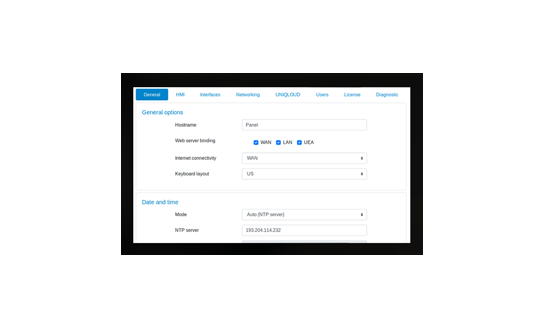30/5/2022
[PASM-13] Add more logs required for security and monitoring as requested by the DfS
[PASM-23] Changed the message shown when applying a configuration.
[SM-640] Add Orientation settings on all devices with a display
[SM-617] Hidden device name in web interface for OEM devices -> only WP50/55/100 OEM.
[LNXASEM-1635] Add support for intel i210 (only HMI/LP/WP45/50)-> only HMI/LP/WP50.
25/1/2022
[SM-469] You can share a folder via SMB protocol when UNIQO or CODESYS software are installed on the system -> not WP50/WP100.
02/11/2021
[LNXASEM-1524] The recovery image has been updated -> only HMI/WP100.
15/10/2021
[SM-501] The configuration page has a new user interface to make the setup operation as easy and straightforward as possible.
06/7/2021
[LNXASEM-1137] Update Chromium to version 88 -> only WP50.
12/4/2021
[SM-433] Add support for Wi-Fi configuration in SystemManagerCli.
[SM-449] Add support for date and time configuration via SystemManagerCli.
[SM-464] Mouse mode option is available for devices with a resistive display -> not RK/RM/DM.
3/3/2021
[SM-422] SystemManagerCli (through the command --showNetworkInterface) now shows the addresses assigned by DHCP.
[SM-431] Add an instant flush of data to external media.
[LNXASEM-926] Virtual keyboard is disabled when an external USB keyboard is detected at boot
[LNXASEM-926] Mouse pointer is displayed when an external USB mouse is detected at boot
5/2/2021
[SM-414] Add the possibility to use the microSD as an external storage device (only for Linux devices)
[SM-425] External storage devices have read-write rights for all users
[LNXASEM-878] Add support for modem Quectel EG25-G
11/12/2020
[SM-405] The "user" can set up the keyboard layout, the display section, and the time of date section (only for Linux devices, the available configurations depending on the device).
[SM-411] USB key remains mounted even if it contains the XML device configuration file. -> not WP
17/11/2020
[SM-343] Add a local NTP server that will listen to connections on the standard UDP port 123.
[SM-374] Add support to install third-party applications.
[SM-376] Add support to configure network interfaces using SystemManagerCli -> only LP
[LNXASEM-768] Add NTP server (default is disabled).
[LNXASEM-812] Add Factory Reset support of file "customer.tar.gz".
2/9/2020
[SM-342] Add support for using USB flash drives in QApplication.
Extend the import of the UNIQO HMI projects by preserving the application files. -> Not WP
15/7/2020
[SM-316] Add a new option to delay the start of applications (only for HMI devices).
Disable special keys when Chromium is active.
Add support for CODESYS Runtime update. -> Only LP
Add support for LP50 update. -> Only LP
23/6/2020
Add support for the import of UNIQO projects via USB key. -> Not WP
6/4/2020
[SM-287] Add support to the latest version of the Router modem -> WP and LP
[SM-298] The product name is not visible on the device configuration page for OEM images. [OEM] -> Only WP








